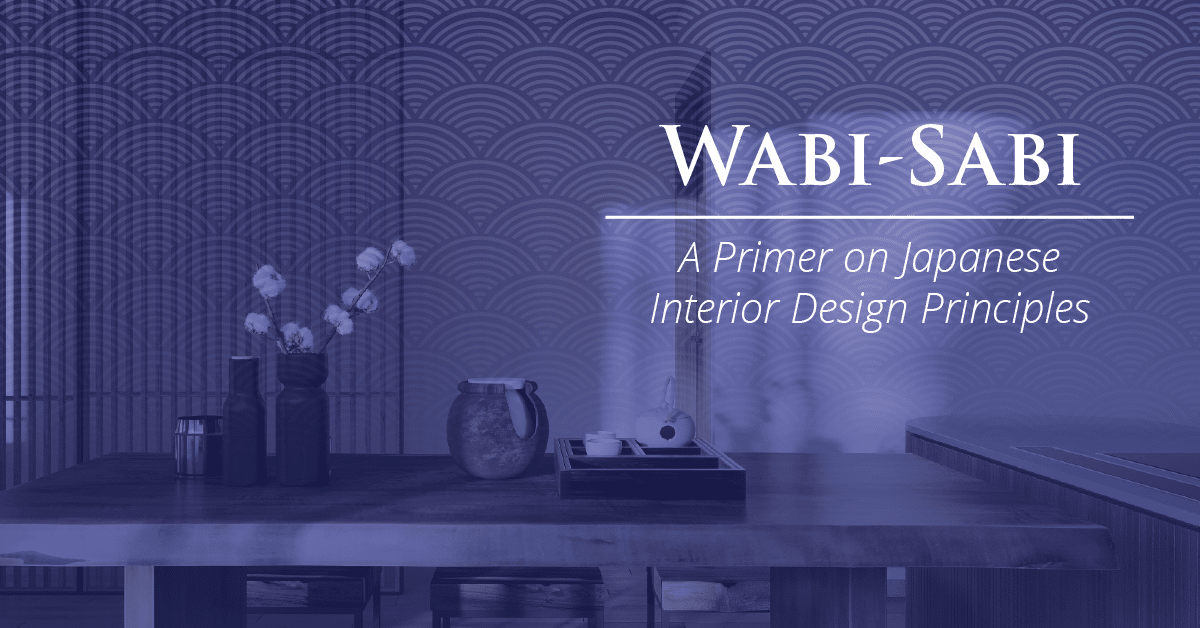Wabi-sabi: A Primer on Japanese Interior Design Principles
By: Melecio Martin G. Arranz IV

Japanese interior design is known for its simplicity, elegance, and delicateness. The use of light and airy interiors with neutral colors and furniture made of natural materials is common in many Japanese structures. Altogether, these ideals pay a fitting tribute to minimalism and nature. One of these principles is wabi-sabi.
As a design philosophy, wabi-sabi focuses on finding beauty in imperfections. It promotes freedom from society’s rules, acceptance of nature’s flaws, and simplicity from the world’s clutter.
This infographic shows you all that you need to know about wabi-sabi, how it can manifest in your condo unit, and how it can improve your overall wellbeing.

What is Wabi-sabi?
Wabi-sabi is an ancient Japanese concept that’s rooted in Zen philosophy. The word “Wabi” means simplicity and imperfection. This is where the line “less is more” is relevant. On the other hand, “Sabi” refers to the acceptance of aging and life as it is.
Together, they form a principle that promotes beauty in imperfection, impermanence, and simplicity. It also looks to nature and its characteristics as the main inspiration for everything. Overall, wabi-sabi is the appreciation of aging, flaws, and life detached from the world’s materialistic obsessions.
While wabi-sabi is often applied in art, culture, and basic objects, it can also be seen in Japanese interior design. The philosophy promotes the use of earth tones and rust shades for colors, as well as natural materials like wood, steel, and stone in the house’s interior.
Many modern properties like condominiums already adopt the aesthetic principles of wabi-sabi. For example, Federal Land’s The Grand Midori Ortigas condominium takes inspiration from Zen philosophy. It features minimalist interior designs and Japanese gardens that aim to embody relaxation and recreation in the middle of a bustling city.
The Seven Pillars of Wabi-sabi
The broader concept of wabi-sabi can be atomized by delving deeper into its seven pillars. Knowing these pillars can help you appreciate how this principle manifests itself in interior design, especially for condos.
Kanso | Simplicity
Kanso focuses on achieving simplicity by getting rid of unnecessary objects. This is best demonstrated by Japanese organizing consultant Marie Kondo, who became known for teaching the habit of disposing of items that no longer spark joy.
Culturally speaking, kanso is already inherent in Japanese homes, as most are small and have limited storage space. As such, homeowners keep only what they need and appreciate their simplified and peaceful surroundings.
Federal Land’s projects adopt kanso in their storage features, as well. For instance, units at The Seasons Residences come with Japanese storage systems to help residents conserve space, giving them enough comfort and flexibility in their condo
Yugen | Subtlety
Wabi-sabi also incorporates the concept of mysterious profundity or subtleness, also known as Yugen. This aesthetic principle focuses on implied beauty rather than superficial appearance, such as the story behind a piece of art instead of what the eyes see on the surface.
At home, Yugen can be represented in furniture such as translucent dividers or curtains. They add a dash of mystery by concealing specific parts of a room without blocking them completely from view.
Shizen | Naturalness
Most Japanese homes, both traditional and modern, have elements of wood, bamboo, and stone incorporated into their structures. While functional, this design style can also be attributed to Japan’s principle of shizen or connection to nature.
Shizen recognizes the physical, emotional, intellectual, and spiritual connection that humans have with nature. It promotes the use of natural materials when building a house or purchasing furniture and other household items, as they are inherently appealing to humans.
The Seasons Residences design concept practices shizen with amenities representing the four seasons of Japan. For example, its well-equipped gym and garden landscapes will evoke the fresh beginnings of spring; its pool, karaoke room, and game room call to mind the fun of summer; its music room, reading lounge, and business center signify the quiet autumn that inspires creativity. Finally, the onsen or Japanese hot spring and spa is a representation of winter.
Seijaku | Tranquility
Seijaku is the state of energized calm. When you declutter your home, you have less furniture and fewer household items to clean and upkeep. This relieves you from the pressure of spending on repairs, cleaning items, and even new furniture you plan to get in the future.
This same principle is applied in The Seasons Residences in a subtle way. To make the drainage system easier to maintain while being aesthetically pleasing, the property is equipped with a below-floor drainage system. It also prevents leaks from occurring, saving you the headache in the long run.
Koko | Austerity
Koko represents restraint, exclusion, and omission. When you adhere to this principle, you focus on the raw and basic elements of an object to get a real sense of its purpose.
The principle of Koko complements Kanso. On top of subtracting clutter from your life, you prevent it at the onset.
When it comes to interior design, this means not purchasing excess furniture just to fill empty spaces in your condo unit. Koko also requires you to see the value in belongings so that you know when and where to make the right investments.
Fukinsei | Asymmetry
Fukinsei emphasizes the fact that life is beautiful despite its imperfections. It focuses on the good in asymmetry and irregularity, as well as the comfort in the world’s occasional chaos. By adopting fukinsei in your condo unit and everyday lifestyle, you’re free from the pressures of perfection.
Fukinsei is best represented by home decorations such as bonsai trees and ikebana flower arrangements. Here, asymmetry is one of the aesthetic guidelines when arranging a bonsai. Designers typically alternate branches in the left, right, and back parts of the tree, with no two branches having the same height nor being close to each other.
The Grand Midori Ortigas was designed with this in mind. Its interiors focus on the discovery of beauty in asymmetry in nature. Its name “Midori,” which means green—the color of fresh shoots, new leaves, and young plants, is represented in its lush greeneries that evoke the look and feel of a zen garden in the middle of a bustling city.
Datsuzoku | Freedom
When you accept the imperfections of nature and life, you also open yourself up to the unknown and unconventional. This is the very meaning of datsuzoku. When you apply this principle to your life, you free yourself from the pressures of rules, limitations, and standards of society.
Since it promotes freedom, datsuzoku lets you explore a myriad of ideas in interior design. For example, upcycling rugs into a new item can give them a new purpose, or using vases with cracks can extend their lifespan. It could also mean creating DIY furniture and crafts that are not strictly traditional to inject some eccentricity into a room.
Adopt Wabi-sabi in Your Condo Unit Today
The wabi-sabi pillars mentioned above promote more than just minimal aesthetics. They also offer worldviews that can help you achieve comfort in your condo unit and, ultimately, a more peaceful life.
If you’re in the process of finding your dream condo unit, consider looking for properties that will allow you to practice wabi-sabi and Zen philosophy. This is especially important if you plan to live in the city but still want to achieve peace and serenity.
You can also directly consult with an interior designer regarding your preferences. Ask them about their design aesthetics and past projects that possibly incorporated the pillars of wabi-sabi.
There are many condos for sale in the Philippines that can help you achieve wabi-sabi. Federal Land offers thoughtfully designed RFO and pre-selling condominiums with curated facilities and amenities. Our projects are located in prime spots with high investment potential in the Philippines. Send us a message to learn more about our projects.

